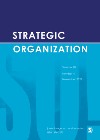A Personal Reflection on Strategic Organization — the Journal (and Field) That Almost Wasn’t
Joel Baum at the University of Toronto discusses the origin story of the journal Strategic Organization in his paper, “Constructing Strategic Organization – A field whose time has come,” published in … Strategic Organization.
It’s hard to believe that Strategic Organization is completing publication of its 20th volume. Although we (Royston Greenwood, Dev Jennings and I) certainly had oversized ambitions for the journal, I’m not sure we imagined that the journal could possibly accomplish as much as it has in such a short time. Indeed, the journal almost didn’t happen in the first place. As a preamble to our essay, “Strategic Organization – a field whose time has come,” in this blog, I will recount a little more of the journal’s backstory.
While I was completing the editing for the Blackwell Companion to Organizations (2002), Rosemary Nixon, my editor at Blackwell, asked if I might be interested in starting a new strategy journal with a design of my own choosing. I immediately answered yes, and also knew immediately what the focus would be. But I also knew that I would not do it alone, as I had foolishly done on the Companion.
The focus would be Strategic Organization, which had been a developing theme for me when I joined the Rotman School of Management at the University of Toronto in 1997 and began working with Brian Silverman. It was while working with Brian both on our joint research and building the strategy group at the Rotman School that the Strategic Organization concept crystalized for me.
In our research, we explicitly connected concepts and ideas from strategy and organization to gain new insight into the interrelated dynamics of firms’ human capital, social capital, innovation and economic performance. We were also, by training, interdisciplinary in our approach and eclectic in our methods. But, we agreed to give priority to rigor and relevance rather than any particular discipline or empirical approach. Our joint efforts gained traction and resulted in several of both of our most highly cited publications.
As we developed our research ideas, the logic for building our strategy group also emerged. We would combine strategy and organization, which were increasingly separated by specialist journals, divisions of the Academy, and business school departments. We would emphasize disciplined but remain discipline-neutral research rather than favor any one discipline over another. We would emphasize rigorous research, but be agnostic to the empirical approach through which rigor was achieved. Over the past 20 years, this conception has informed the growth and coming to prominence of the Rotman School strategy group, as it has Strategic Organization.
While the journal’s focus and principles were at the ready when I agreed to start the journal, enthusiastic co-editors were not. I sought two other scholars to co-edit the new journal with me — not just to share the heavy lifting, but to complement my primary disciplinary and empirical orientations in order to signal the principles of Strategic Organization as well as establish connections across the subfields, subdisciplines and empirical orientations of strategy and organization research.

I certainly understood the reluctance of the outstanding scholars I asked to join me as coeditors — starting up a journal is a daunting task. And while everyone I spoke with agreed to serve (and did) on the journal’s founding editorial board, I found myself wondering if I should be more reluctant too. While entertaining these second thoughts, I found myself enjoying a beer at the 2001 Academy of Management conference with my good friends Royston Greenwood and Dev Jennings. At some point during our conversation, I looked up from my glass, first toward Royston, then toward Dev, and finally blurted out “Hey, a publisher asked me to start up a new strategy and organization journal… you two want to co-edit it with me?” They looked at each other, shrugged, then looked back at me and replied, “Sure. Sounds fun!” Simple as that.
With Royston and Dev on board as founding co-editors, and a solid core editorial board recruited during my earlier conversations, we wrote a formal proposal for the publisher. Peer reviewers gave the proposal a strong endorsement and so Rosemary presented the proposal to her publisher. Meanwhile, in the year that had passed since Rosemary and my original conversation, Blackwell had decided to take its journal collection in a “different direction”, and the proposal was declined. Before I could shed a tear, sigh of relief, or whatever other reaction I might have had, Rosemary informed us she’d shared the proposal and reviews with a colleague at SAGE who was interested in the project, and in short order, Strategic Organization had a publisher.
The rest, as they say, is history. And you can read our thoughts on that history (so far) in the essay Royston, Dev and I wrote for the 20th Anniversary Special Issue of Strategic Organization, along with those a range of others involved with the journal over the past two decades. In our essay, we describe our original inspirations and aspirations for the journal, look back on the progress the journal has made toward achieving them (spoiler alert: we think it has realized them remarkably!), and look ahead at what we think the journal and the Strategic Organization research community might profitably give more attention to in the near future.
My great thanks to everyone who has had anything to do with Strategic Organization over the years — coeditors, editorial board members, reviewers, authors, readers. It has been a great honor, privilege, and pleasure to be a part of Strategic Organization‘s first 10 years, and to watch from the sidelines these past ten. I hope you enjoy our essay. Here’s to the roaring 20s!














![Share Your Most Surprising Policy Citation for Chance to Win $500 [Closed] Share Your Most Surprising Policy Citation for Chance to Win $500 [Closed]](https://www.socialsciencespace.com/wp-content/themes/conferpress/images/default_thumbnail-new-border.jpg)























































































